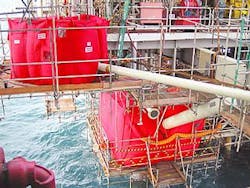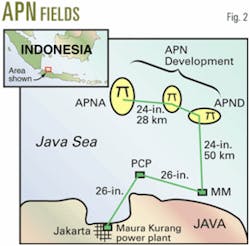Four custom built isolation chambers for structural welding proved effective for minimizing platform shut downs on BP PLC’s operated APN-MM development project in the Java Sea, off Indonesia, according to Hot-Hed Inc., the manufacture of the chambers.
The company said that its habitat chambers (Fig. 1) allowed the project to carry out hot work continuously for 16 days on the MM platform without interrupting the flow of gas to the electric power plants in Jakarta.
It estimated that the habitats saved BP 10 days of production that otherwise would have been lost on the MM platform.
APN project
The recently completed APN field development in the Arjuna field complex, about 100 km northeast of Jakarta is in 15-45 m water depths (OGJ, May 20, 2004, p. 8). The project included the installation of three monopod platforms linked by 28 km of 24-in. infield pipelines and a 50 km, 24-in. pipeline to the existing MM gas compression platform (Fig. 2).
The development ties into BP’s West Java gas grid that supplies gas to Jakarta for electric power generation.
Habitats
The habitat chambers provide a positive pressure environment to allow safe hot work such as welding, cutting, and grinding on a live platform. Hot-Hed’s developed the chambers in 1998 (OGJ, May 4, 1998, p. 90).
The company describes the habitats as flexible, inflatable structure that can be modified to suit all areas and fit around awkward installations and space.
Work on the MM platform included welding of new support beams to allow for the installation of a new module that supports a configuration of control valves for fields tied into the MM platform.✦




